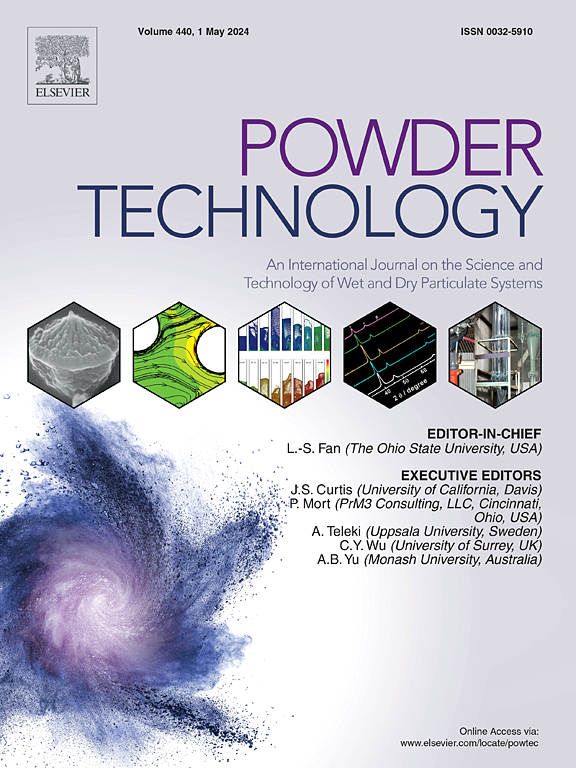用于水力结合建筑材料的高炉矿渣配方
IF 4.5
2区 工程技术
Q2 ENGINEERING, CHEMICAL
引用次数: 0
摘要
通过气体雾化技术对熔渣进行干粉造粒,可以减少高炉炉渣(BFS)传统湿法加工过程中的资源消耗。炉渣是炼铁过程中产生的副产品,随后被加工成细粉,用于制造建筑材料。熔融雾化工艺广泛应用于金属粉末生产,经调整后可将炉渣加工成细小、无定形的球形颗粒。因此,本研究利用新开发的雾化器,对高温雾化工艺的开发、由此产生的矿渣颗粒特性以及雾化高炉矿渣粉(ABFS)在建筑材料中的适用性进行了研究。研究表明,高炉矿渣粉经适当雾化后可形成球形、无定形颗粒,这些颗粒具有优异的流动性和较低的卡尔指数。利用加热的雾化气体和较高的雾化气体压力可增加直径小于 200 μm 的小颗粒的含量,最高可达粉末质量的 60%。雾化矿渣粉具有与研磨矿渣粉相当的潜在水力特性。在混凝土中使用直径小于 90 μm 的雾化矿渣粉时,其效果接近于含有传统加工矿渣的配方。这样,混凝土配方中所需的含水量就可以减少,混凝土配方的二氧化碳排放量也可以降低。因此,液态 BFS 可通过热气雾化直接加工成球形和无定形颗粒,由此产生的矿渣粉可用于建筑材料。本文章由计算机程序翻译,如有差异,请以英文原文为准。

Formulation of blast-furnace slag for use in hydraulically bound construction materials
Dry powder granulation of slag melts by gas atomization offers a means of reducing the resource expenditure associated with the conventional wet processing of blast furnace slags (BFS). Slags are a by-product of the iron production process and are subsequently processed to create a fine powder, which is then used in the manufacture of building materials.
The melt atomization process, which is widely used in metal powder production, was adapted to process the slag into fine, amorphous and spherical particles. Therefore, this study investigates the development of an adapted high-temperature atomization process utilizing a new developed atomizer, the resulting properties of the slag particles, and the suitability of atomized blast furnace slag powders (ABFS) for use in building materials.
It is demonstrated that BFS can be properly atomized to form spherical, amorphous particles that exhibit excellent flowability and a low Carr-Index. The utilization of heated atomization gas and high atomizing gas pressure increases the content of small particles below 200 μm in diameter with up to 60 % of the powder mass. The atomized slag powder exhibits comparable latent hydraulic properties as ground slag powders. The utilization of the atomized slag powder fraction below 90 μm in concrete approaches the results of formulations containing conventionally processed slag. In this way, the requisite water content in concrete formulations can be diminished, and the concrete formulation's CO2 footprint may be reduced. Consequently, liquid BFS can be directly processed into spherical and amorphous particles through hot gas atomization and the resulting slag powder can be utilized in building materials.
求助全文
通过发布文献求助,成功后即可免费获取论文全文。
去求助
来源期刊

Powder Technology
工程技术-工程:化工
CiteScore
9.90
自引率
15.40%
发文量
1047
审稿时长
46 days
期刊介绍:
Powder Technology is an International Journal on the Science and Technology of Wet and Dry Particulate Systems. Powder Technology publishes papers on all aspects of the formation of particles and their characterisation and on the study of systems containing particulate solids. No limitation is imposed on the size of the particles, which may range from nanometre scale, as in pigments or aerosols, to that of mined or quarried materials. The following list of topics is not intended to be comprehensive, but rather to indicate typical subjects which fall within the scope of the journal's interests:
Formation and synthesis of particles by precipitation and other methods.
Modification of particles by agglomeration, coating, comminution and attrition.
Characterisation of the size, shape, surface area, pore structure and strength of particles and agglomerates (including the origins and effects of inter particle forces).
Packing, failure, flow and permeability of assemblies of particles.
Particle-particle interactions and suspension rheology.
Handling and processing operations such as slurry flow, fluidization, pneumatic conveying.
Interactions between particles and their environment, including delivery of particulate products to the body.
Applications of particle technology in production of pharmaceuticals, chemicals, foods, pigments, structural, and functional materials and in environmental and energy related matters.
For materials-oriented contributions we are looking for articles revealing the effect of particle/powder characteristics (size, morphology and composition, in that order) on material performance or functionality and, ideally, comparison to any industrial standard.
 求助内容:
求助内容: 应助结果提醒方式:
应助结果提醒方式:


